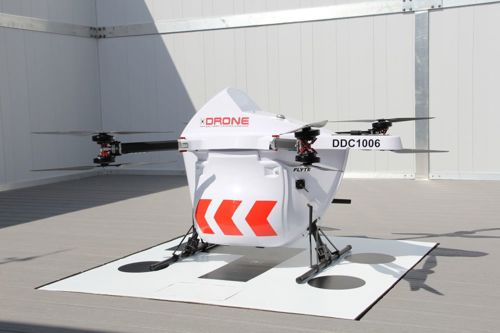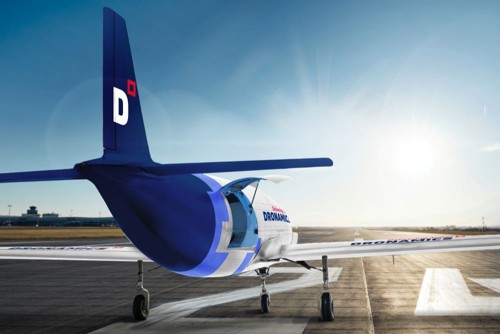
Innovation often comes in tough times and that was the case for Skyports Drones Services, according to Director Alex Brown, who says business took off during the pandemic.
It created the need for improved access to medical supplies, particularly in rural and hard-to-reach areas, combined with the challenge of worker illness or isolation, this made unmanned services valuable.
Brown says, “We partnered with the NHS and Royal Mail on several projects across the UK to carry real payloads, including pathology samples and medicine, to demonstrate how drone operations can connect communities and improve access to critical services.”
It has resulted in improved services, Brown explains, “When our drones fly in Argyll and Bute in Scotland for the NHS we shave 19 hours off the end-to-end transport time for blood going from arm to lab. That means that patients get their pathology results back 19 hours sooner. That’s a gamechanger. Imagine the impact on the UK health system if every patient living in a rural area could start medical treatment hours earlier.”
Comparing its fleet to a company like Royal Mail, which has different vehicles for different jobs, Skyports from ones that can carry 4kg up to 180km to larger ones which can carry 10kg up to 15km to the STOL heavy cargo service which can carry 200kg up to 400km.
Operating with limited infrastructure is an advantage of drones, especially VTOL aircraft. Even Skyports’ Pyka Pelican Cargo only requires an unpaved runway measuring 400 feet for take-off and landing.
Brown says, “In Singapore, we provide drone-in-a-box services with our investor and partner ST Engineering. The drone-in-a-box technology solution enables aircraft to take off, land, dock, battery swap, and take off again, requiring minimum human intervention due to its highly automated nature – all within six minutes.”
Also in Singapore, Skyports is working with Jurong Port on a maritime focused cargo vertiport containing cargo warehousing, customs, communications technology, operational and maintenance services for maritime drone deliveries.
The market really accelerated in 2022 with Skyports receiving enquiries from all over the world meaning the team is spending a lot of time with partners, regulators and suppliers to prepare for new operations.
The operations team has doubled in 12 months and Skyports is recruiting so it can continue rolling out its services. This year will be the biggest yet with projects in all parts of the world.
Having completed several proof of concepts, Skyports is focusing on commercial, permanent operations with Brown commenting, “It’s one thing to demonstrate the technology for a few months, it’s another whole thing to embed a daily, permanent, sustainable service.”
As a key player in a new industry, Skyports feels it has a responsibility to demonstrate the advantages of drones not just to customers and end users but also regulators and the public. Skyports is working with regulatory bodies and legislatures to shape laws and guidance.
Brown says, “One of the key challenges is creating regulations that are fit for purpose, risk based, performance led, and proportionate to the operations we perform. We are working closely with regulators globally to implement the right level of regulation to enable impactful, beneficial and, fundamentally, safe operations.”

Reaching rural communities
Established in 2014, the idea behind Drone Delivery Canada (DDC) was to use drone technology to overcome the challenges of last-mile deliveries in remote and hard-to-reach areas of Canada, particularly the north.
Since then, DDC has developed a proprietary drone delivery platform including hardware and software components for secure, reliable and cost-effective delivery of goods.
CEO Steve Magirias says that DDC is working with Transport Canada and other regulatory bodies to ensure its drones comply with aviation regulations and it is working with large organisations such as Air Canada, DSV and Canada Post to bring its drones to market.
Since its launch, DDC has developed three drones starting with the Sparrow, which can carry 4kg up to 20 kilometres. The Sparrow was succeeded by the Canary, which has the same payload and range, and the Condor is DDC’s heavy lift drone with a payload of up to 180kg and a range of 200 kilometres.
DDC is working on technology to improve the safety and reliability of drone services including Beyond Visual Line of Sight (BVLOS) to operate autonomously over long distances and Detect and Avoid (DAA) technology to detect and avoid collisions other with other air traffic.
In 2019, DDC has granted a Special Flight Operations certificate by Transport Canada and it has completed several pilot projects and established commercial operations across Canada.
Services include working with the Moose Cree First Nation to deliver supplies to rural communities in northern Ontario and partnering with the University of British Columbia to deliver medical goods to a first nation community.
Magirias says, “DDC has made significant progress in moving its drone technology beyond the experimental stage and is now operating its drones in real-world environments to provide innovative and practical solutions to a range of logistical challenges.”
The emergence of drones is a challenge for regulators and authorities, with Magirias commenting, “While many regulatory bodies have made efforts to keep pace with the rapid technological advancements in the drone industry, it is fair to say that, in many cases, they are playing catch up.”
Regulators have to balance safety and security concerns with the potential benefits drones bring, especially when operating around sensitive or restricted areas such as airports or military bases.
The risk of collisions with other aircraft and drones being used for illegal activities are other issues regulators need to consider.
Clear and consistent regulations that apply across different jurisdictions will also be needed to avoid confusion. Progress is being made with the US Federal Aviation Administration introducing regulations governing the operation of drones including registration, pilot certification and safety standards. The European Union Aviation Safety Agency has also developed a framework governing the use of drones.
Magirias says, “Overall, while regulators may be playing catch up in some areas, there is a growing recognition of the need to establish clear and effective regulations to ensure that the benefits of drone technology can be realised while minimising the risks posed by their use.”
It will take time for drones to be accepted as a normal part of the cargo ecosystem, Magirias admits, citing airspace restrictions, infrastructure requirements, public perception, technological limitations and weather and environmental conditions.
He says, “The successful integration of cargo drones into the normal cargo ecosystem will require addressing a range of regulatory and infrastructure challenges, and overcoming these challenges will require collaboration between industry stakeholders, regulatory bodies and governments.”
When the technology develops so that drones can carry heavier payloads over longer distances, Magirias believes and efficiency and reliability will make them more attractive for governments and businesses. Regulatory frameworks are necessary but regulators are actively working on this. The public need to be confident about drones for them to be accepted.
Magirias says, “As the public becomes more familiar with drones and their capabilities, and as concerns about safety and privacy are addressed, it is likely that cargo drones will be increasingly viewed as a viable and necessary part of the cargo ecosystem.”
It is hard to predict when drones will be a normal part of the ecosystem, Magirias concludes, “There is no doubt that they have significant potential to transform the way goods are transported, and their use will likely become more widespread as technology and regulatory frameworks continue to evolve.”

Middle distance
Most drone developments have focused on last-mile deliveries but the team at Dronamics believes that the middle mile is where drones are the most valuable, says Co-Founder and CEO Svilen Rangelov.
He founded Dronamics in 2014 with his brother, Konstantin, while they were both studying abroad to solve the problem of delivering packages across Europe in a fast, cost-effective and green way.
Since then, the team has grown to 150 members in 12 countries and last year it became the first cargo drone airline to obtain a licence to operate in Europe.
The Black Swan cargo drone has been developed to serve the middle mile with a payload of 350kg and a range of up to 2,500 kilometres.
Rangelov says it is up to 80% faster, 50% cheaper with 60% lower CO2 emissions than other transport methods available today.
Dronamics offers a full-stack service with a network of droneports, mobile control and cargo handling operations. Droneports can be deployed at airports, airfields and landing strips, and only requires 400 metres for taking off and landing.
The network operation can is powered by fully mobile droneport cargo equipment and Dronamics’ autonomous and semi-autonomous remote fleet control system.
Rangelov says, “This means that we can reach remote areas where traditional aircraft cannot, making it easy to integrate into any business’ supply chain. By eliminating the need for local warehousing, there is a drastic reduction in time, cost and emissions.”
The framework for commercial drone operations is still developing and requires continuous effort from all parties to ensure the highest levels of safety while fostering innovation, says Rangelov.
The regulatory environment is becoming more receptive to innovation, with Rangelov highlighting the UK approving a drone flight corridor and Dronamics taking part in Project Caelus, a trial in Scotland to deliver healthcare products to remote communities.
Last year, the European Commission published its Drones Strategy 2.0 focusing on fostering sustainable and smart mobility through drones.
Rangelov says, “Dronamics is proud to be IATA’s first strategic partner for drones worldwide. It took us seven years to get from napkin design to obtaining a licence and we’ve faced multiple challenges along the way. Being the first cargo drone company to do that is a testament to the first movers advantage we have.”
He believes it will take time for drones to be a common sight, despite the rapid development in recent years.
Rangelov says, “This year marks exactly 10 years since Jeff Bezos’ announcement of Amazon drones inspired us to do something quite different. Despite the subsequent development of cargo drone companies, drone deliveries are still considered a novelty. However, as drone technology continues to improve and regulations become more established, the adoption of cargo drones is the future. We are here to democratise airfreight worldwide and make same day delivery an option for everyone, everywhere.”
This article was published in the April issue of Air Logistics International, click here to read the digital edition and click here to subscribe.
